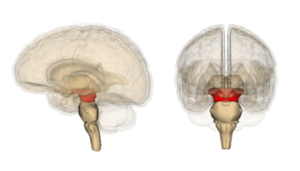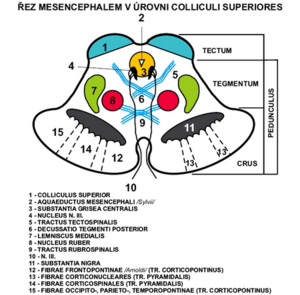Midbrain
The mid brain /mesencephalon/ is the most rostral part of the brainstem, and it builds on the Varol's bridge.
It connects the rhombencephalon to the diencephalon. It measures about 2cm in length. Practically all of it is covered by the hemispheres of the endbrain, only its ventral part is visible as the so-called crura cerebri (partes anteriores pedunculi cerebri) – massive trunks containing white matter. The middle brain runs through the aquaeductus mesencephali' (Sylvii) - a narrow channel, leading cerebrospinal fluid, after a distance from IV. ventricles.
Aquaeductus m. is lined with a layer of gray matter substantia grisea centralis.
The midbrain can be divided into several parts - the tectum mesencephali and the pedunculus cerebri (which consists of the tegmentum mesencephali and the crura cerebri).
Pedunculus cerebri is placed ventrally from the aquaeductus muscle.
Crura cerebri (partes anteriores pedunculi cerebri) – also part of the pedunculus cerebri. They are lateral and sink under the optic tract into the base of the brain.
Between the two trunks is the 'fossa interpeduncularis. Its surface is perforated the course of a series of vessels, therefore it is called substantia perforanta posterior' (interpeduncularis). Be careful not to confuse the substantia perforanta anterior, which is part of the endbrain!
In the fossa interpeduncularis, medially from the pedunculi, the n. oculomotor III.
Ventral from the fossa interpeduncularis are the corpora mamillaria, which already belong to the diencephalon. The following cranial nerves depart from the midbrain – III, IV (II runs here already as a pathway, not the optic nerve). The cranial ends of the reticular formation also extend here.
Tectum, "quadrupedal" in English, lies dorsal to the aquaeductus mesencephali. It contains two pairs of bumps - colliculi superiores et inferiores.
They are involved in the visual pathway and the auditory pathway and continue as brachium colliculi superioris et inferioris to the corpus geniculatum laterale a mediale' diencephalon.
Caudal to the colliculi, the pedunculi cerbellares superiores extend, another in the series of cerebellar pathways. As with the pedunculi cerebellares inferiores, the velum, more precisely, the velum medullare superius, forming the cranial part of the IV ceiling, is opened here. chambers. Cranially from the tectum is the area pretectalis, which already belongs to the diencephalon.
Nuclei of the tectum mesencephali :
- predominantly sensitive pathways (sight and hearing)
a) Nc. colliculi superioris - fibers from the retina of the eye as well as motor and somatosensitive
b) Nc. colliculi inferioris - auditory cortex center
c) Nc. commissurae posterioris
d) Ncc. pretectales - nc. tractus optici
Tegmentum (partes posteriores pedunculi cerebri) – ventral from the tectum, part of the pedunculus cerebri.
The border between the crura and the tegmentum forms the substantia nigra.
Substantia nigra - pigment in the perikarya, the outer part goes to the crura and has a net-like appearance (pars reticularis) and the inner part goes to the tegmentum (pars compacta) producesdopamine.
It contains a number of important pathways and cores. On the side, a gentle elevation is visible - trigonum lemnisci, where the lemniscus medialis runs.
Nuclei of the tegmentum mesencephali :
- mainly motorized pathways
a) Nc. ruber - oval, large, reddish, between substantia nigra and aquaeductus, regulation of limb movements
b) Nc. nervi oculomotorii - by the aquaeductus, a group of several nuclei sends somatomotor fibers to the n. oculomotorius, which innervates 4 of the 6 oculomotor muscles, controls the movements of the eyeball
c) Nc. accessorius n. oculomotorii - dorsal from nc. nervi oculomotorii, visceromotor parasympathetic fibers, m. ciliaris and sphincter pupillae, movements of the eyeball
d) Nc. interstitialis Cajal - small, dorsal from nc. nervi oculomotorii, is related to the gray matter of the substantia grisea centralis and to the rostral part of the formatio reticularis, part of the fasciculus longitudinalis medialis
e) Nc. Darkševiči - small, fibers from the cerebellum, cortex of the telencephalon, vestibular nuclei of the rhombencephalon
f) Nc. nervi trochlearis - small, at the substantia grisea centralis, caudal from n. III, somatomotor fibers innervate m. obliquus superior bulbi
g) Nc. mesencephalicus nervi trigemini - long and slender, it goes here from the rhombencephalon, laterally from the aquaeductus, sensitive muscle and joint receptors of the masticatory muscles, artic. temporomandibularis and oculomotor muscles
Pathways of the mesencephalon :
- afferent to ncc. collicules superiores from the retina of the eye, from the spinal cord, rhombencephalon, from the visual cortex
- from the ncc. cochleares to the colliculi inferioris
Sources[edit | edit source]
Connected articles[edit | edit source]
Source[edit | edit source]
- ČIHÁK, Radomír – GRIM, Miloš. Anatomie 3. 2., upr. a dopl edition. Grada, 2004. vol. 3. pp. 673. ISBN 80-247-1132-X.


